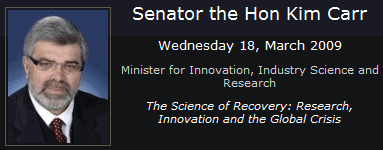|
|
|
|
|
|
|
News & Views item - March 2009 |
![]() Senator Carr Reiterates His Prescriptive Approach to Australia's University
Sector. (March 18, 2009)
Senator Carr Reiterates His Prescriptive Approach to Australia's University
Sector. (March 18, 2009)
 To
coincide with the second day of the Federation of Australian Scientific and
Technological Societies' (FASTS) annual two day event of "Science Meets
Parliament" the Minister for Innovation, Industry, Science and Research, Kim
Carr, addressed the National Press Club.
To
coincide with the second day of the Federation of Australian Scientific and
Technological Societies' (FASTS) annual two day event of "Science Meets
Parliament" the Minister for Innovation, Industry, Science and Research, Kim
Carr, addressed the National Press Club.
Of consequence was the minister's announcement that the "Australian Government will provide up to $83 million to early stage start-up companies – who have been starved of funds due to the global financial crisis.
"In order to help these firms ride out the financial storm, $83 million will be offered in follow-on funding to over twenty venture capital fund managers licensed by the Commonwealth under existing programs. The fund managers will use this money to invest in innovative firms bringing promising new technologies and services to market".
According to the Senator's media release "the Government will be providing a full response to the Review of the National Innovation System as part of the budget process, but today’s announcement is an important part of building a stronger national innovation system. Funds will flow to companies as soon as possible".
Apart from that announcement, Senator Carr's address to the NPC was a rambling rehash of his previous pronouncements with regard to the holding of universities to account, pressing for hubs and spokes, and the universities providing defining missions from which the Rudd government, through Senator Carr, will draw up compacts, a requirement for providing significant funding.
There was also the reiteration of a nebulous promise but now couched in ponderous humour:
The first of these ambitions is to progressively address the gap in funding for
the indirect costs of university research, subject to the capacity of future
budgets.
I’ve had some very flattering press on this one since I
announced it ten days ago, with some greeting it as the most important
university reform in a generation.
As much as I like being told I’m greater than Humboldt – I
insist on it around my own office – it may be time for a reality check.
Even in my own rare moments of diffidence, I recognise that I
haven’t surpassed the brilliant Prussian thinker who pretty much invented the
modern university – at least not yet.
And finally a remarkable closing section:
The future
There is one other kind of collaboration I’d like to see more of, and that’s collaboration between the natural and human sciences.
The Age of Wonder – that interval between the voyage of the Endeavour and the voyage of the Beagle – owes much of its appeal to the fact that this apparently self-evident division was still invisible to most intellectuals. This was an age when John Constable could call painting “a branch of natural philosophy, of which pictures are but experiments”. (“The History of Landscape Painting”, Fourth Lecture at the Royal Institution, 1836) It was an age when Humphry Davy could explain that he did science because he loved narrative – a passion inspired by his Cornish grandmother’s legends and ghost stories. (Holmes, p. 239) Here was a man for whom each discovery was a tale waiting to be told.
It gave me particular pleasure to create a stream for the humanities, arts and social sciences in the International Science Linkages Program last year – and to leave the name of the program just as it was. It was a joy to reinstate a much older and more inclusive sense of the word “science”, which once referred to knowledge in all its forms.
Perhaps this is the definition we should be using when we talk about rallying science to the cause of recovery.
It will be a long campaign, and we will need all the
reinforcements we can get.